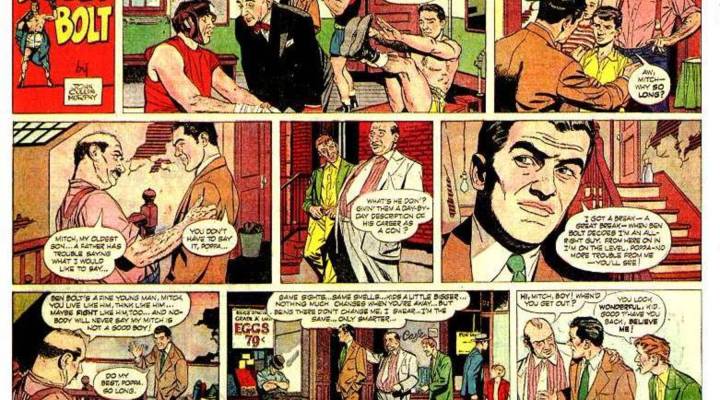
Growing up in "Cartoon County"

What’s the best part about reading the newspaper? The comics. But weekly comics have fallen out of favor along with the decline in print readership. For Cullen Murphy, these comics represent more than the jokes they contain. They represent his childhood. Cullen’s father, John Murphy, was a popular cartoonist during the heyday of the form. Marketplace host Molly Wood speaks with Cullen Murphy about his new book “Cartoon County: My Father and His Friends in the Golden Age of Make-Believe.”
Molly Wood: So this is such a story of your childhood, which is so different and unique and special. What was it like growing up with a cartoonist for a dad?
Cullen Murphy: It was pretty wonderful. You have to remember that I grew up in a part of Connecticut where most people were not cartoonists. But there was a group of about 100 people who were. Most of the people were commuters, but the cartoonist stayed home and my dad was one of those. He did a strip called “Big Ben Bolt,” which was about a prize fighter. And then he did a strip called “Prince Valiant,” which was about a knight in the Middle Ages, and after school, unlike almost any other kid in the neighborhood, we could go to the studio and basically hang out.
Wood: And did people — you said that there was this sort of community all around, people doing the same thing. But did people outside of his community take his job seriously?
Murphy: I don’t think my mother’s parents ever really fully accepted that what he did was work. I don’t think he really regarded what he did as work. One of the happiest places that he ever spent time in was the studio. His family came out there all the time. He was living in something of an invented world, creating stories that weren’t real — except that they were putting food on the table.
Wood: Talk about the power of images. Because, you know, even if there’s not the same high value placed on cartoons now, it seems like the right cartoon at the right moment can have a huge impact politically, socially, all kinds of ways.
Murphy: There’s something about the comic strip form that I think responds to something that’s hardwired into the human psyche. This combination of words and picture, there’s something about this one-two punch that we respond to very powerfully, and I think that’s a permanent part of our culture. We see a efflorescence nowadays of graphic novels, which really are the successor to comic strips, but it’s fundamentally the same dynamic at work, I think.
Wood: Yeah, must feel like you could carry that forward and also say that Instagram and internet memes — you know, funny pictures with funny captions —are digital versions.
Murphy: Absolutely.
Wood: So how have technology, and specifically the internet, impacted the cartoon industry?
Murphy: Well, they’ve had a big impact not directly, but indirectly. The real impact has been on the newspaper business. I think the recent data are that Sunday newspaper readership is down by something like 3 million people a year. And since Sunday newspapers along with daily newspapers are the natural ecosystem for comic strips, you don’t need McKinsey or Bain to come and tell you what the effect of this is going to be. That’s not to say, though, that the form itself — you know, the basic storytelling with images and words — is a dying art, because I think it’s not. I think we’re at the beginning of a new golden age.
Wood: Do you have a favorite comic or cartoon strip then or now?
Murphy: I’ve always loved “Prince Valiant.” I think “Prince Valiant” had the adventure strip. It had the romantic novel. It had some of the humor of what are called “Big Foot” strips, although it’s done in a more formal and novelistic way. The illustrations have been, you know, beautiful. And, it has really stood the test of time. You know, it’s been going since 1937. It’s been [in] several different hands, but it has gone from glory to glory.
There’s a lot happening in the world. Through it all, Marketplace is here for you.
You rely on Marketplace to break down the world’s events and tell you how it affects you in a fact-based, approachable way. We rely on your financial support to keep making that possible.
Your donation today powers the independent journalism that you rely on. For just $5/month, you can help sustain Marketplace so we can keep reporting on the things that matter to you.


















